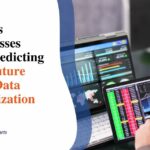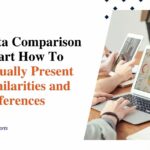Creating Compelling Visuals: Pie Charts for Effective Data Storytelling
Grasping the essence of complex data can be a daunting task. Did you know that pie charts are powerful visual aids in enhancing data understanding? This blog post will walk you through how to effectively use pie charts for compelling data storytelling.
Let’s dive in and make numbers more meaningful!
The Importance of Data Storytelling
Data storytelling is crucial because it inspires change, explains complex information, engages the audience, and enlightens them with insights from data.
Inspire change
Good stories make us feel. They move us to act. Data storytelling can do the same thing. It can light a fire under people to change how they think or behave. When we see numbers in a pie chart, it’s not just math anymore.
We see problems that need fixing and chances for new things to happen! This is how data storytelling inspires change. It shows us where we are now and points the way to a better future.
Explain
Effective data storytelling is crucial for capturing and holding the attention of your audience. It allows you to inspire change, engage your viewers, and enlighten them with valuable insights.
By using narrative techniques, you can craft a compelling story that makes sense of numbers and maximizes the effectiveness of your message. Visual storytelling plays a critical role in this process as it helps communicate complex information in an easily understandable way.
Creating clear and intentional visuals, such as pie charts, can further enhance your data storytelling by providing a visual representation of your key points. With pie charts, you can segment your audience effectively and convey important information at a glance.
When used correctly, they become powerful tools for making data more accessible and engaging for everyone.
In order to create effective pie charts for data storytelling purposes, there are some tips to keep in mind. Firstly, consider the benefits and limitations of pie charts to ensure they are the right visualization choice for your data set.
Engage
Engaging your audience is a crucial aspect of effective data storytelling. To capture their attention and keep them interested in your information, you need to create visuals that are visually appealing and easy to understand.
Use colors, labels, and legends that are clear and concise. Keep the design simple and avoid cluttering the chart with unnecessary details. Make sure the information is presented in a logical order so that it flows smoothly for your audience to follow along.
By engaging your viewers through compelling visuals, you can ensure that they stay focused on the story you are telling with your data.
Enlighten
To enlighten your audience through data storytelling, it is essential to deliver clear and concise information that they can easily understand. Use visuals, like pie charts, to present complex data in a visually appealing and straightforward way.
Keep the design simple and ensure that each chart focuses on conveying one main idea or message. By using pie charts effectively, you can illuminate your data story and help your audience grasp the key insights quickly and easily.
Essential Elements of Effective Data Storytelling
Relevant and impactful data, a clear narrative, intentional visuals, and one graph per story are key elements of effective data storytelling. Want to learn more about how these elements can enhance your data storytelling? Read on!
Relevant and impactful data
To create compelling visuals and effectively tell a data story, it is crucial to use relevant and impactful data. This means including information that is directly related to the main message or objective of your story.
By focusing on the most important data points, you can grab your audience’s attention and keep them engaged throughout your presentation. It’s also essential to ensure that the data you present has a significant impact on your audience or helps them gain valuable insights.
By choosing data that resonates with your audience and aligns with their needs, interests, or concerns, you can make your storytelling more powerful and persuasive.
When selecting relevant data for storytelling purposes, think about what will resonate most with your target audience. Consider their preferences, biases, knowledge level, and motivations when making decisions about which information to include.
Additionally, prioritize facts and statistics that support the narrative you want to convey or help drive home a specific point. Avoid overwhelming your audience with excessive numbers or complex charts/graphs; instead, choose concise visual representations of the key findings or trends in order to communicate effectively.
Clear narrative
A clear narrative is an essential element of effective data storytelling. It helps to guide the audience through the data and create a sense of understanding. A clear narrative connects the different data points, presenting them in a logical and coherent way.
By organizing the information in a structured manner, it becomes easier for people to follow along and grasp the main message being communicated. A well-crafted narrative also adds depth and meaning to the data, making it more relatable and memorable for the audience.
With a clear narrative, you can effectively communicate your insights and engage your audience in a meaningful way.
Intentional visuals
Intentional visuals play a crucial role in effective data storytelling. When crafting visual representations of data, it is important to be intentional and purposeful in the choices we make.
This means selecting visuals that enhance the story we are trying to tell, rather than just using them for decoration. By carefully choosing colors, fonts, and layout, we can create visuals that not only grab the audience’s attention but also convey key information clearly and concisely.
Intentional visuals help us engage our audience and ensure that our message is understood effectively.
One graph, one story
To effectively communicate data, it’s important to remember the principle of “one graph, one story.” This means that each graph or visualization should have a clear and specific message.
By focusing on a single story or insight for each graph, you can avoid overwhelming your audience with too much information. A single graph allows you to highlight key trends or patterns in the data and make your message more impactful.
So when creating visuals for your data storytelling, remember to keep it focused and concise by telling one story at a time.
Using Pie Charts for Effective Data Storytelling
Pie charts are a valuable tool for effectively communicating data and enhancing storytelling by visually representing proportions and comparisons.
Benefits and limitations of pie charts
Pie charts are a useful tool for visualizing data because they can show the relationship between different parts of a whole. They are especially effective when you want to highlight the proportions or percentages of different categories.
The main benefit of using pie charts is that they make it easy for viewers to quickly grasp the overall picture and identify patterns or trends. However, pie charts also have limitations.
For example, they may not be suitable for displaying large datasets or comparing more than a few categories. In addition, it can be challenging to accurately read and interpret small slices of the pie chart.
Tips for creating compelling pie charts
To create compelling pie charts for effective data storytelling, here are some helpful tips. First, keep your pie chart simple and easy to understand by using only a few categories or slices.
Make sure each slice represents a significant portion of the whole. Second, label each slice clearly with its corresponding percentage or value. This will help your audience quickly grasp the information you’re presenting.
Third, use colors strategically to enhance readability and highlight important insights. Finally, consider adding a title or caption that provides context and clarifies the main message of your pie chart.
Examples of effective pie chart usage
Pie charts are a useful tool for presenting data in a clear and visually appealing way. They can effectively showcase proportions and percentages, making complex information easier to understand.
A good example of using pie charts is when comparing market shares of different companies or the distribution of budget allocations. However, it’s important to keep in mind that pie charts may not be suitable for displaying large amounts of data or comparing multiple categories at once.
By using these charts wisely, you can create compelling visuals that engage and inform your audience.
Conclusion
In conclusion, using pie charts is a powerful way to visually tell a story with data. By presenting information in a clear and concise format, pie charts can engage and enlighten audiences.
However, it’s important to use them thoughtfully and ensure they accurately represent the data. With practice and attention to detail, you can create compelling visuals that effectively communicate your data story.
FAQs
1. What is the role of pie charts in effective data storytelling?
Pie charts help in making sense of numbers and communicating with data effectively. They are useful tools for plotting a compelling story from data.
2. How can I craft a persuasive narrative using pie charts?
You can use pie charts as part of your data storytelling framework to present clear visuals, creating an engaging plotline development that helps maximize effectiveness and persuasiveness.
3. Are other forms of graphical representation necessary besides pie charts?
Yes, line graphs, bar charts, heat maps or scatter plots are also important for audience segmentation and visual storytelling with data.
4. Can infographics play a part in crafting compelling visuals?
Absolutely! Infographics combine various visualization techniques including pie-charts and bar graphs to aid in effective data communication.
5. How do I create compelling visuals using the right tools?
There are many different data visualization tools available that help you make appealing visuals for your interpretation and presentation of analysis results.
6. Is segmenting my audience important when telling stories with data?
Yes, understanding your audience aids in crafting more relevant narratives using techniques like scattering plots which lead to more value-driven change-making stories.







